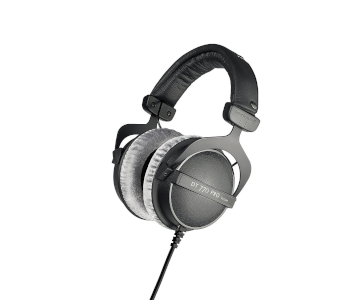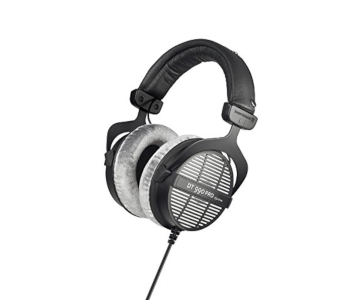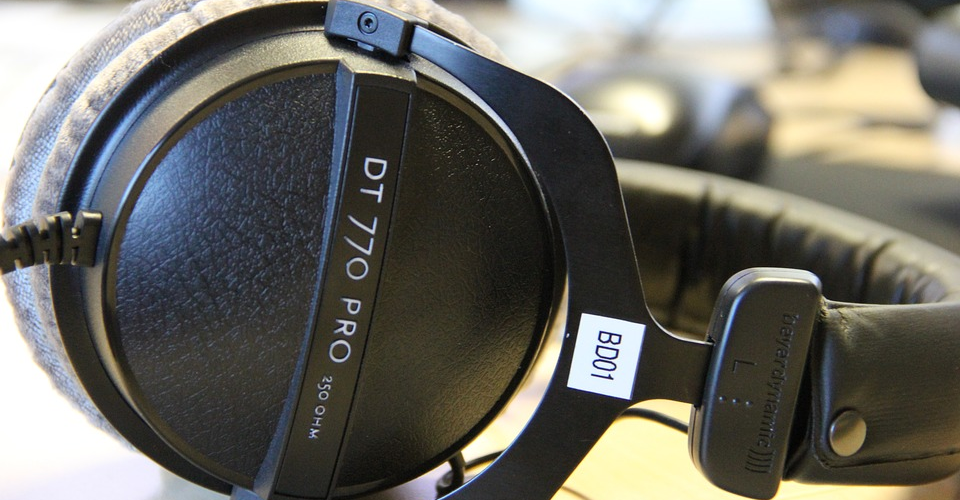Headphones Comparison: Beyerdynamic DT 770 Pro vs. Beyerdynamic DT 990 Pro
The Beyerdynamic DT 770 Pro and the Beyerdynamic DT 990 Pro are some of the best and most popular headphones under $200. They are studio headphones that are also suitable for general media consumption, including listening to music at home and gaming. The two headphones are identical in many aspects, such as comfort, build quality, accessories, and connectivity options. But their ear cup enclosures are different – the DT 770 Pro are closed while the DT 990 Pro are open – which means they are intended for different applications.
If you are having trouble choosing between the DT 770 Pro and the DT 990 Pro, we’ll make things easier for you with this head-to-head comparison. In this write-up, you’ll get a detailed look at the critical differences and many similarities between the two headphones. Beyerdynamic offers multiple variants for the two headphones: 16-ohm, 32-ohm, 80-ohm, and 250-ohm models for the DT 770 Pro, and 80-ohm and 250-ohm models for the DT 990 Pro. This comparison guide applies to all variants of both headphones since the differences between them are minor.
Quick Look
| Beyerdynamic DT 770 Pro | Beyerdynamic DT 990 Pro | |
|---|---|---|
| Type | Wired over-ear | Wired over-ear |
| Enclosure | Closed-back | Open-back |
| ANC | No | No |
| Connectivity | 1/8 in (3.5 mm) analog, 1/4 in (6.3 mm) adapter | 1/8 in (3.5 mm) analog, 1/4 in (6.3 mm) adapter |
| Battery | N/A | N/A |
| Weight | 9.5 oz | 8.8 oz |
| Price | Amazon | Amazon |
Design
The DT 770 Pro and the DT 990 Pro have almost identical designs. They have the same tight but very comfortable over-ear fit, the same excellent build quality, and the same mediocre portability. Both also lack any form of controls for volume adjustment and music management and include the same set of accessories. The DT 990 Pro are more breathable due to their open-back design and always include a coiled audio cable while some DT 770 Pro variants come with straight audio cables. But other than these, there are no other notable differences between the two Beyerdynamic headphones.
Fit
There is minimal difference between the DT 770 Pro and the DT 990 Pro in this category. Both are comfortable over-ear headphones with a well-padded headband and thick earpads covered in velour, which feels nicer on the skin than artificial leather. Their excellent earpads help mitigate their similarly tight clamps while their large, spacious ear cups will easily cover most ear shapes and sizes. They stay securely on your head due to their tight clamp – an especially beneficial attribute in a studio setting, where you need to move around more often.
Both headphones have non-detachable audio cables that only connect to their left ear cups, which allow for better cable management, but their cable designs are not completely the same. The DT 990 Pro and the 250 ohms model of the DT 770 Pro – both of which are meant for professional use – have coiled audio cables; all the other variants of the DT 770 Pro include straight audio cables, which some people find less cumbersome for home use.
Breathability is the only other area where the two Beyerdynamic headphones are different. Although the DT 770 Pro are decently breathable for closed headphones, the DT 990 Pro are more breathable, improving overall comfort and making them more suitable for extended usage. This is not surprising since open-back headphones are typically more breathable than closed-back headphones.
Build

The DT 770 Pro and the DT 990 Pro are identical in this category. Both are known for being some of the best-built headphones under $200, with few moving parts that are susceptible to wear and tear. Their headbands are made of metal, with removable padding covers, while their ear cups are made of durable plastic. Unlike with some open headphones, the grilles on the DT 990 Pro are also made of plastic instead of metal.
For both headphones, all parts are replaceable and spare parts are readily available, improving overall durability. With their tough, durable frames and replaceable parts, the DT 770 Pro and the DT 990 Pro are both well-constructed headphones. They are not as premium as the DT 880 Pro, which have metal grilles, but they are still better built than many other headphones selling for a much higher price. Aside from the exposed wiring on their ear cups, there are no other notable weak spots for both headphones.
The two headphones are also identical in aesthetics. Both have utilitarian designs that will not look out of place in a studio environment. Their color schemes are muted while the branding on their ear cups is simple. They will still stand out if you wear them at the office or in a public place, but only because of their bulky frames and the fact that they look like professional studio equipment.
Controls
Both headphones lack an in-line remote and on-cup controls for volume adjustment and music management. Everything needs to be controlled from your audio equipment or device, but this is hardly surprising for headphones designed primarily for listening to music at home and in the studio.
For the closed-back DT 770 Pro, not having in-line controls can be inconvenient if you intend to use them at the office and during commutes due to their passive noise isolation. But for the DT 990 Pro, which are even more limited in usages because of their open design, the lack of any form of controls is a trivial matter.
If you want an audio cable with an in-line remote – and preferably a detachable one as well – you’ll need to modify your headphones. Replacing the audio cable on both headphones is manageable enough and doesn’t require extreme familiarity with headphone parts and maintenance. There are detailed guides on the internet if you want to modify the DT 770 Pro and DT 990 Pro and equip them with removable audio cables.
Portability
The DT 770 Pro and the DT 990 Pro are not travel-friendly headphones, which makes them unappealing options for people who travel a lot and prefer professional headphones that are more portable. In addition to their identical bulky frames, the two headphones don’t fold into a more compact format to take up less space in your bag. Both are also cumbersome to wear around your neck when not in use since their ear cups are quite large and don’t swivel into a flat position.
Furthermore, both headphones only come with a soft pouch for storage, which is less travel-friendly and offers less protection against physical damage than a hard case. If you want to make them more portable, you can buy a hard case from Beyerdynamic. But there are better options on the market if you prefer professional headphones that are easier to carry for travel – like the Audio-Technica ATH-M50x.
Accessories
The two headphones are identical in this category. Both include a soft pouch and a 1/4 in (6.3 mm) screw-on adapter for interfacing with studio equipment. That’s it. There are no extra earpads, airplane adapters, or additional cables included for both headphones. The lack of other accessories isn’t surprising, as many other studio headphones in the same price range don’t come with a bunch of accessories as well.
Performance
The biggest differences between the DT 770 Pro and the DT 990 Pro lie in the sound and isolation categories, mainly due to their different ear cup enclosures. In all other aspects, the two headphones are practically identical. Both lack a mic and any active features that require a battery, tying them in the mic and battery performance categories. They are also almost identical in connectivity: their analog connection options are the same, but their cable designs are slightly different.
Sound
The DT 770 Pro and the DT 990 Pro are both good-sounding headphones with an emphasized bass and a recessed mid-range. Both also have an emphasized treble that can be harsh in some tracks, but their sound profiles are not the same. The DT 770 Pro are better-balanced and more suitable for different genres. They are also better for recording and monitoring in the studio and for bass reference. Their bass is more accurate while their treble is more pleasant, but their mid-range is less detailed.
The sound differences between the four DT 770 Pro variants are minor and will be unnoticeable for many people unless they are specifically looking for them. The 16-ohm and 32-ohm models have the weakest bass while the 80 ohms model has the most bass impact and presence, which makes it the most suitable for bass-heavy music. The 80 ohms model also has the fullest-sounding mid-range and the smoothest treble among the four variants. Lastly, the 250 ohms model has the most accurate and most neutral mid-range, along with the most treble.
Better-suited for sound mixing and mastering, the DT 990 Pro have a slightly more neutral sound with a more spacious soundstage. The DT 770 Pro also have a decent soundstage for closed headphones, but their open-back counterpart is simply much better on that front. As with the different DT 770 Pro models, there is not much difference between the 80-ohm and 250-ohm models of the DT 990 Pro in terms of overall sound quality.
The DT 990 Pro have a more prominent bass than the DT 770 Pro, which is likely the first thing you’ll notice when comparing the two. Their bass is deep and controlled and has a good impact; among open-back headphones, their bass is one of the best. Their mid-range also has great transparency and detail, but it’s more recessed, while their treble is more pronounced and more detailed. Overall, they are the more all-around headphones that are suitable for studio use, gaming, and watching movies.
For the 80-ohm and 250-ohm models of both headphones, you’ll need an amp to get the most out of them, whether you intend to use them in the studio or mainly for enjoying music at home. For the mobile-friendly 16-ohm and 32-ohm models of the DT 770 Pro, you can directly plug them into your smartphone or laptop without using supplementary audio equipment.
Isolation

With their closed-back ear cups, the DT 770 Pro naturally provide better sound isolation than the open-back DT 990 Pro. They are better at passively blocking out background noise and have a lower sound leakage. The latter aspect makes them better for recording in the studio since their leakage will not be audible enough to be picked up by your mic. While their sound leakage is still higher than that of other closed headphones, the DT 990 Pro are far worse in that department.
The DT 770 Pro are certainly not the kind of headphones you’d want to use if you want noise isolation in very loud places. They are not ideal for commuting and flights, especially considering their mediocre portability. But their passive noise isolation is good enough for listening to music at home, in the office, and in a studio environment. They are decent at reducing high-frequency noises and ambient chatter, but not against low-frequency noises.
Like all other open-back headphones, the DT 990 Pro have poor sound isolation. They will hardly block any background noise and have a high sound leakage, which means people around you will hear whatever you are listening to. Whether you are gaming, watching movies, or listening to music, you need to be mindful of the sound leaking out from the headphones, especially if someone is trying to sleep beside you.
Mic
Both headphones lack any kind of mic for calls. As with the in-line remote, this omission is not surprising for professional studio headphones. If you want to use them for online multiplayer gaming, especially the open-back DT 990 Pro, you can modify and outfit them with a boom mic for voice chat.
Battery
With no active features that require battery power, both the DT 770 Pro and the DT 990 Pro lack internal batteries that you need to manage and keep track of. This means you can use them as much as you want without worrying about them running out of power at an inconvenient time.
Connectivity
The two headphones have the same connectivity options. Both are limited to a wired connection, which is a non-issue for home and studio use but can be inconvenient if you intend to use them in other environments. Their non-detachable audio cables similarly end with 1/8 in (3.5 mm) analog plugs for easy compatibility with most devices – including portable music players, computers, smartphones, and gaming consoles. As mentioned, both headphones include a 1/4 in (6.3 mm) screw-on adapter.
Although it can be inconvenient sometimes, the wired connectivity of both headphones eliminates latency issues, which is beneficial for gaming and watching video content. Wired headphones are also easier to connect to different gaming platforms. You can connect them to any gaming device that includes a regular headphone port – including the Nintendo Switch Lite and the wireless controllers of PS4 and Xbox One consoles.
Despite their identical analog plugs, the audio cables of the DT 770 Pro and the DT 990 Pro are not completely the same. The DT 990 Pro include a coiled audio cable – which is useful for studio use but can be annoying in a non-studio setting – whether you get the 80-ohm model or the 250-ohm model. For the DT 770 Pro, the audio cable depends on which model you get. The 250 ohms model also comes with a coiled audio cable, but all the other models include a straight audio cable.
Wrap-up
| Beyerdynamic DT 770 Pro | |
|---|---|
| The DT 770 Pro are the better option if you want headphones with a more balanced sound profile for a variety of music genres. They are also more suitable for bass reference and for recording in the studio, with their lower sound leakage being especially beneficial for the latter. Their passive noise isolation is also better, which adds to their versatility and makes them more suitable for listening to music in moderately noisy places. Overall, the DT 770 Pro are some of the best closed-back headphones under $200, with excellent marks in bass accuracy, comfort, and build quality. | |
| Pros | Cons |
|
|
| Beyerdynamic DT 990 Pro | |
|---|---|
| If you prefer headphones with a more open sound, go for the DT 990 Pro. Their open-back design automatically means they have a better soundstage and more breathable ear cups for even better comfort during extended use. Although their sound isolation is much worse, they are more all-around headphones that are better-suited for sound mixing and mastering in the studio and for gaming and watching movies at home. As with their closed-back counterpart, the DT 990 Pro are some of the best open-back headphones under $200 and offer great value for the money. | |
| Pros | Cons |
|
|

